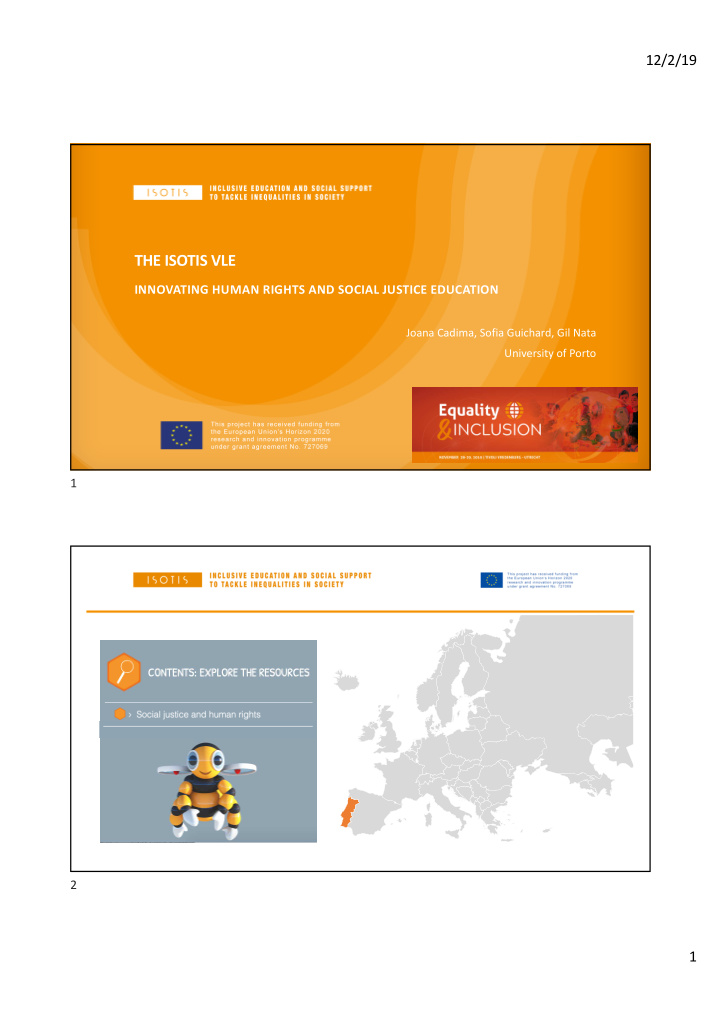



12/2/19 THE ISOTIS VLE INNOVATING HUMAN RIGHTS AND SOCIAL JUSTICE EDUCATION Joana Cadima, Sofia Guichard, Gil Nata University of Porto 1 2 1
12/2/19 Context of the intervention in Portugal : Public school with children from pre-school to 9 th grade; • #children : ≈126 children (1- 9 th grade) #teachers : 2 teachers School as a democratic learning space: • • Students are responsible for managing their learning experiences & actively contribute to the school life; • School organized in common centres rather than classrooms: 13-15 yrs 11-13 yrs 6-10 yrs Tutors (educational supervisors) rather than teachers; • 3 Exploratory phase - Exploration of school documents Needs according to ISOTIS team Team of - Meetings with teachers ISOTIS team teachers - Observation of school activities • Not necessarily a focus on social justice education contents ONGOING SOCIAL JUSTICE PRACTICES Co-construction of goals • Children live and actively contribute to equality within the school • Documenting existing practices for context; sharing in the VLE platform • School structure is aligned with social justice: • Bring social inequalities education into • School assembly; school activities and curriculum • School materials; • Group of responsibility: solidarity. 4 2
12/2/19 Co-Design and Implementation phases 1st step 2nd Step 3rd Step Starting Point Research Project Take action • To introduce the topic of social and • To enable children as researchers; • To foster discussions on human economic inequalities; rights, human dignity, social justice • To promote children’s and equity; • To introduce the concepts of understanding of the justice and fairness; interdependence of people and • To develop agency and provide a countries throughout the world; pathway to action towards a just • To gauge children’s interests and world. knowledge about the topic of • To promote children’s inequalities; acknowledgment that profits are not divided equally among those • To promote children’s expression involved in trade. of ideas and perspectives. … co-design co-design co-design implement. implement. implement. 5 1st step • Children watch a video What do we want to learn Starting Point Group discussion and sharing about social inequalities? • 2 3 1 6 3
12/2/19 1st step Starting Point Children: 1 st to 4 th grade 7 2nd Step • Children search information Research Project How can we learn about social inequalities? Group discussion and sharing • 2 1 8 4
12/2/19 2nd Step Research Project Children: 1 st to 4 th grade 9 2nd Step Research Project Children: 1 st to 4 th grade Parental involvement Whole group discussion Whole group work 10 5
12/2/19 2nd Step Research Project Children: 1 st to 4 th grade digital map physical map Whole group work Other possibility! 11 3rd Step • Group discussion/debate What can we do about social inequalities? Take action Joint actions in the school • 4 2 1 3 12 6
12/2/19 3rd Step Take action Children: 1 st to 4 th grade 13 3rd Step Take action Children: 1 st to 4 th grade 14 7
12/2/19 3rd Step Take action Children: 1 st to 4 th grade 15 3rd Step Take action Whole group discussion Children: 1 st to 4 th grade What can we do about inequalities in trade? 16 8
12/2/19 3rd Step Take action Children: 1 st to 4 th grade Children’s ideas about what could be done were registered in the VLE as an inspiring example for other children/teachers: “we can go to the “we can do a “we can help the supermarket and ask manifestation” farmer” how much each one receives” “I know who can help us (...) Marcelo Rebelo de “call the police and complain” Sousa [Portuguese President]” 17 Three lessons learned from the intervention Following children’s interests and motivations was combined with a clear 1 and strategic focus on contents and knowledge related to social inequalities, aligned with a coherent theoretical framework (Asia Society/OECD, 2018), showing how an intervention can be successful in combining local/specific needs and interests and theoretical/learning goals. 18 9
12/2/19 Three lessons learned from the intervention Providing concrete content and data for children to explore and 2 examine can be an important lever for children to confront their personal and superficial perspectives with clear and developmentally appropriate information. 19 Three lessons learned from the intervention ICT tools, such as the ISOTIS VLE , can foster children’s motivation 3 and interest in learning, but teachers need structural conditions , time and support to use tools such as the VLE in their daily practices. 20 10
12/2/19 LET’S TRY IT! Joana Cadima, Sofia Guichard, Gil Nata University of Porto 21 11
Recommend
More recommend